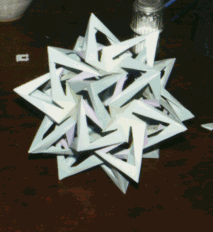 (annotated picture)
(annotated picture)
Also, before I start to describe this, a caveat on purity: These directions require you to cut paper to specific rectangular sizes before folding. The directions for module #1 call for cutting the module with scissors. This is not necessary. You can achieve the same functionality by folding. However, it is too hard for me to diagram that. I use glue to make my models permanent, however, this model does not require it for stability (for example, the one pictured above was not glued). If any of this offends you and your definition of "origami," please just call it what you want and don't send me email.
If you would rather have the above diagrams in pdf (it should also print better), click here.
In the picture above, the type #1 modules are the light blue ones that compose the points. The type #2 modules are the light green ones that compose the star-like dimples, and the type #3 modules are the light purple ones.
Once you've made the modules, you put them together as follows. I encourage consulting the above picture or the annotated picture while you put it together.
First, take three modules of type #1, and call them X, Y, and Z. Insert tab 1A of module X into slot 1B of module Y. Next insert tab 1A of module Z into slot 1B of module X. Finally, insert tab 1A of module Y into slot 1B of module Z. You now have made one of the points. Do this with all the type #1 modules until you have 20 points.
Now, take five modules of type #2 and call them V, W, X, Y and Z:
Now here is where you'll do best to consult a picture. Tab 1D of the type #1 modules goes into slot 2C of the type #2 modules. The "points" get arranged in groups of five around each dimple. To solidify the module, tabs 3A and 3B of the type #3 modules go into the 1C slot of the type #1 modules. The type #3 modules will always go between type #1 modules of different points. This is sketchy at best, but combined with the picture, you should be able to figure it out.
This polyhedron will be very solid without glue; however, if you don't glue it, it will tend to sag after 2-3 months. I'd estimate that it takes me between 12 and 20 hours to make one of these, depending on how difficult the paper is to work with, and whether or not I'm gluing it.
If you do make one of these, please send me a picture:
Jim Plank Department of Computer Science 203 Claxton Complex Knoxville, TN 37996 plank@cs.utk.edu